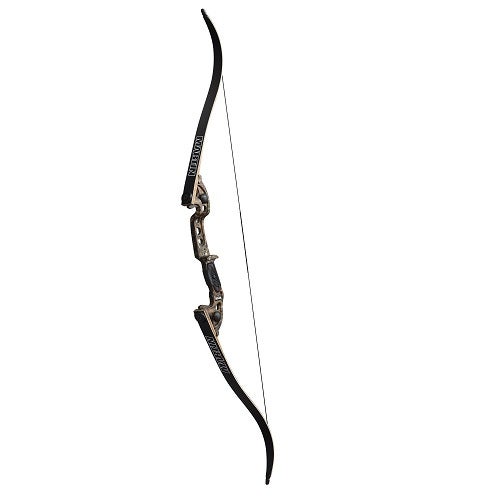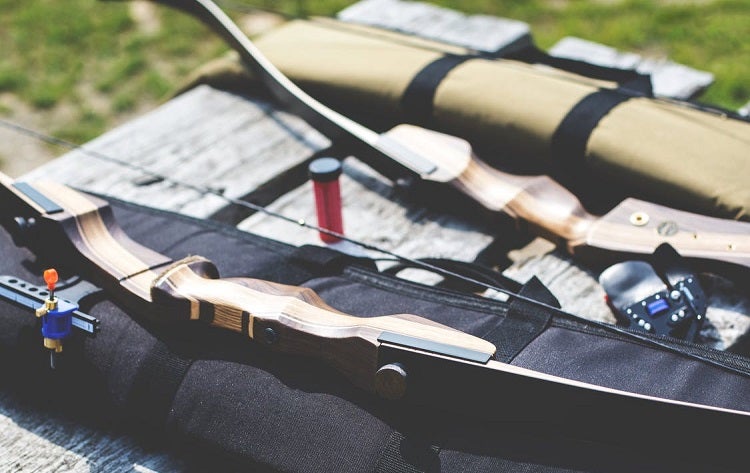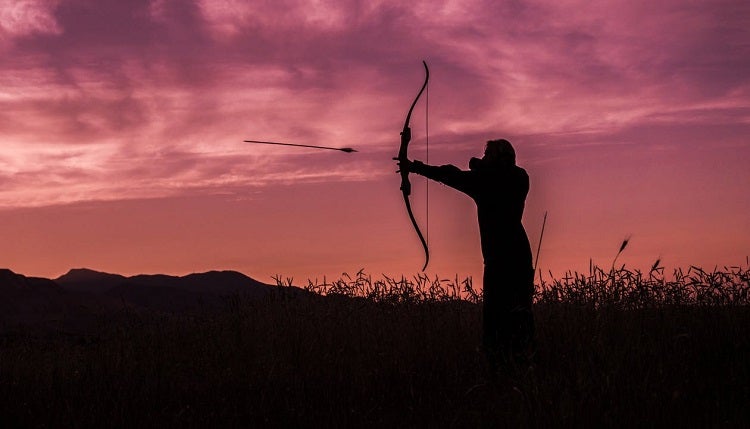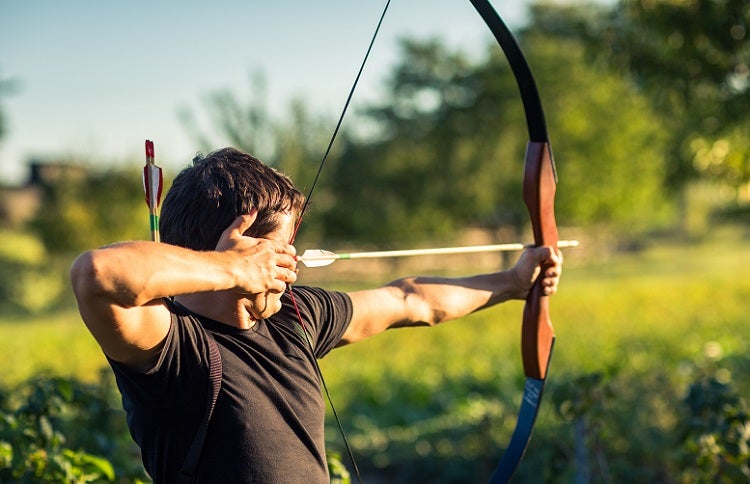
Our Editors independently research, test, and rate what we feel are the best products. We use affiliate links and may receive a small commission on purchases.
Picking out the best recurve bow for your needs can be confusing, especially if you’ve never used a bow before.
When I was a kid, I grew up in a hunting family. I learned to shoot bows around the yard when I was a kid and grew up losing arrows at just about anything around me.
They really were the best of times. My father got me a compound bow and I took a doe with it on my very first day of hunting. It was boring honestly, it was too easy with a compound bow.
That was when I decided to switch to a recurve bow. I’ve been shooting stick bows exclusively ever since.
Best Recurve Bows
For more of my archery recommendations, have a look through these popular Outside Pursuits guide links: Compound Bows, Crossbows, Pistol Crossbows.
Quick Answer: The 7 Best Rated Recurve Bows For 2021
- SAS Courage 60″ Hunting Takedown Recurve
- Bear Archery Grizzly Traditional Recurve Bow
- SAS Spirit Jr Beginner Youth Takedown Recurve
- Martin Archery Jaguar Elite Bow
- Bear Archery Sonoma Recurve
- Martin Archery Hunter Recurve Right Hand Bow
- Spyder XL 64 inch Takedown Recurve Bow
Our reviews of the top rated recurve bows with our guide and comparison table will help you choose the right one for you.
Recurve Bow Reviews
#1 SAS Courage 60″ Hunting Takedown Recurve
- Draw Weight: 35 -60 pounds
- Draw Length: 60 inches
- Limbs: Maple and Fiberglass
- Rating: 4.6 / 5.0
Like most recurve bows today, this takedown bow is made from laminate wood limbs with glass reinforced facing.
While there is a preinstalled threaded brass plunger for mounting sights or stabilizers, you’d be better off without them.
If you’re looking to put sights, stabilizers, etc onto a bow you’d be much better off with a compound bow that can actually take advantage of those upgrades.
Southland Archery Supply covers this recurve takedown bow with their 3-year manufacturer warranty which is a nice feature for a new bow!
This covers replacement of defective bows, repair of defective products, and other failures that are a fault of the manufacturer.
Available in both right and left hand models you can choose from 35 – 60 pound draw weight. If you’re using it for hunting try to stick with 45+ pounds of draw. Overall I would say this is my top pick for the best recurve bow.
#2 Bear Archery Grizzly Traditional Bow
- Draw Weight: 30 -60 pounds
- Draw Length: 58 inches
- Limbs: Maple and Fiberglass
- Rating: 4.7 / 5.0
With tons of rave reviews from happy users, it’s hard to make a mistake with a bow that gets nothing but top marks.
This 58” bow is a great choice for archers with draw lengths of 22” – 24” looking for a reliable recurve bow. Draw weights on this bow range from 30 – 60 pounds with both right and left hand models.
If you’re looking to take the bow hunting, you’ll need a minimum of 40 pounds to bring down a deer from close range.
Limbs with higher draw weights are available for larger game or longer distances, I would say this is the best recurve bow for hunting on our list.
#3 SAS Spirit Jr Beginner Youth Takedown Recurve
- Draw Weight: 16-29 pounds
- Draw Length: 54 inches
- Limbs: Maple and Fiberglass
- Rating: 4.6 / 5.0
This bow comes from the same maker as the Samick Sage and Spyder XL. It’s specifically designed for use by kids or beginners and fits well with those who have smaller hands or extremely low draw weight needs.
It’s available in both left and right-hand models from 12 – 22 pounds of draw weight. True to its name, the bow takes on a laminate yellow and cream color banding that’s quite beautiful.
I do like that this bow has fixed takedown screws which have large thumb operated screws. No special tools are needed and the draw weight is fixed so it’s easy to establish a good routine with this bow.
It’s a 54” bow which, according to our chart below, means a 17 – 20” draw length is appropriate. For the price, it’s hard to argue especially since kids will outgrow a bow within just a few years. In my opinion this is the best youth recurve bow.
#4 Martin Archery Jaguar Elite 45# Bow
- Draw Weight: 45 pounds
- Draw Length: 60 inches
- Limbs: Maple and Fiberglass
- Rating: 3.8 / 5.0
Martin is a name that carries a reputation for quality in the archery world. This one’s a bit different in that the bow is made of two largely separate components. The riser (handle area) is made from a modern aluminum / magnesium alloy.
This makes the bow durable and allows for many versatile options such as adding sights, quivers, or other accessories you may want.
Both bow limbs are made from a more traditional wood laminated with glass backing. I like that they made this wooden recurve bow purposefully easy to disassemble.
It’s available in both 40 and 45 pound draw weights. They have included a string and a stringer in the package so you’ll have everything you need to get started (minus the arrows).
Note that this is a right handed bow, as long as you are a right handed shot this is the best takedown recurve bow.
#5 Bear Archery Sonoma Recurve
- Draw Weight: 40-45 pounds
- Draw Length: 60 inches
- Limbs: Multi-laminate limbs
- Rating: 3.7 / 5.0
Bear Archery is a maker that’s been around for a very long-time crafting bows in the US. Originally based in Michigan, they moved their facility to Florida in the 70’s.
This 40 – 45-pound draw weight bow is 60” long and appropriate for users with about a 22” draw length. It’s another great recurve bow and suggested for archers ages 14 and up.
You’ll be impressed with the price as they’ve managed to keep the overall cost down quite low. While it is a right hand only model (drawing with the right hand, holding the bow with the left) there are plenty of models available for you lefties.
This is a good choice for beginners, kids, or those without the ability to pull heavier draw weight bows. The Sonoma is probably the best recurve bow for target practice.
#6 Martin Archery Freedom Recurve Right Hand Bow
- Draw Weight: 25-55 pounds
- Draw Length: 62 inches
- Limbs: Eastern Hard Maple laminations and Fiberglass
- Rating: 5.0 / 5.0
We’re making a big leap in quality and price with the Martin Freedom bow. This is a single piece traditional recurve (not take down). It’s a wood laminate glass backed bow with tons of power and snap.
Like Bear Archery, Martin Archery has been around for ages and knows how to make a bow. You’ll choose from a draw weight between 35 – 65 pounds.
The bow weighs just 2 pounds overall and stands a beautiful 62 inches tall strung.
If you’re an established recurve shooter or an archer demanding only the best quality and performance this is the bow of choice for you. At 62” tall the bow will work well for people with a 24” + draw length which is common for many adult males.
Without a doubt, this bow is a great choice for everything from target to hunting. Beware though because it’s impossible to disassemble and transporting a bow can be hard with a small or compact car.
#7 Spyder XL 64 inch Takedown Recurve Bow
- Draw Weight: 30 -55 pounds
- Draw Length: 64 inches
- Limbs: Maple / Red wood and Fiberglass
- Rating: 4.5 / 5.0
This 64 inch long recurve bow is a takedown model that is available in draw weights from 30 – 55 pounds.
According to our chart (below in our guide) that makes it a 24 – 26” draw length bow, but the advertiser says it belongs to users with draws over 28”.
Who to believe? Well, I looked but couldn’t find an actual manufacturer’s website. I did, however, notice that it’s carried by several non-specialty retail chains which makes me question the truthfulness of the measurement.
In all honesty, I would default to the specs provided in our weight – to – length chart below. This bow should probably be for users with draw lengths of 24 – 26”, not 29+ as the website says.
That said, the price is quite affordable and users rate the bow highly for its durability, accuracy, and reliability. Confusion aside, and lack of real information from the manufacturer, it would make a good entry level take down recurve.
Recurve Bows Comparison Table
| Recurve Bow | Draw Weight | Length | Takedown | Limbs | Rating |
|---|---|---|---|---|---|
| SAS Courage Hunting Recurve | 35 -60 lbs | 60 inches | Yes | Maple & Fiberglass | 4.6 / 5.0 |
| Bear Archery Grizzly Traditional Bow | 30-60 lbs | 58 inches | No | Maple & Fiberglass | 4.7 / 5.0 |
| SAS Spirit Jr Beginner Youth Takedown Recurve | 12-22 lbs | 54 inches | Yes | Maple & Fiberglass | 4.6 / 5.0 |
| Martin Archery Jaguar Elite | 45 lbs | 60 inches | Yes | Maple & Fiberglass | 4.1 / 5.0 |
| Bear Archery Sonoma Recurve | 45-45 lbs | 60 inches | Yes | Multi-laminate limbs | 3.7 / 5.0 |
| Martin Archery Freedom | 45-55 lbs | 62 inches | No | Eastern Hard Maple laminations and Fiberglass | 5.0 / 5.0 |
| Spyder X Recurve Bow | 30 -55 lbs | 64 inches | Yes | Maple / Red wood & Fiberglass | 4.5 / 5.0 |
How to Choose the Best Recurve Bow – Buyers Guide
- Draw Weight
- Take Down Recurves vs Traditional Recurves
- Why Choose a Recurve?
- Hunting Recurves Versus Target Recurves
- Draw Length
- Takedown Recurve Comparison
- Best Recurve Bow Brands
- FAQ For Recurve Bows
- Conclusion
Draw Weight
Choosing a draw weight on your bow is a combination of knowing how you’ll use it, and staying within your physical limits.
Draw weight refers to the amount of force required to pull back the string on a bow. There’s a big difference between stick bows and the world of compound bows, though!
Your new recurve has no let off once you draw it back. That means an 80-pound draw recurve is 80 pounds the entire time you draw and hold it.
If that doesn’t make sense to you, what I’m saying is that you won’t be able to “hold” your recurve and wait for the perfect moment.
With a compound, an 80% or more let off is common. This allows an 80-pound bow to feel like a 16-pound bow once you have it fully drawn.
Recurves don’t work like that.
You may want to reduce the draw weight of your bow if you’re making the switch. Anything above 40 pounds should be able to take down a deer with a good shot.
For larger game, longer distances, or other situations you may want a recurve with a draw weight of 60+ pounds.
Take Down Recurves vs Traditional Recurves
A traditional recurve is a single beautiful piece of wood from front to back. There can be no disassembly without breaking the bow. Take down bows are not the same.
On take down bows, the limbs are attached with adjustable screws which can be completely removed to make the bow smaller.
These adjustable screws also allow you to increase or decrease the draw weight within a range. It’s not uncommon to have an adjustable draw weight from 45-60 pounds for instance
Video: How to Set Up a Recurve Bow
Why Choose a Recurve Bow?
Today your options are crossbows, recurves, long bows, or compounds. Until recently compound bows have been the most popular modern option among hunters. With the lifting of restrictive crossbow regulation, crossbows are rapidly overtaking the market.
Since time immemorial (okay, historians probably know an actual date in history), longbows are recurves have historically been the bow of choice for many applications from hunting to war. Many recurve users today relish the rich history of their bows.
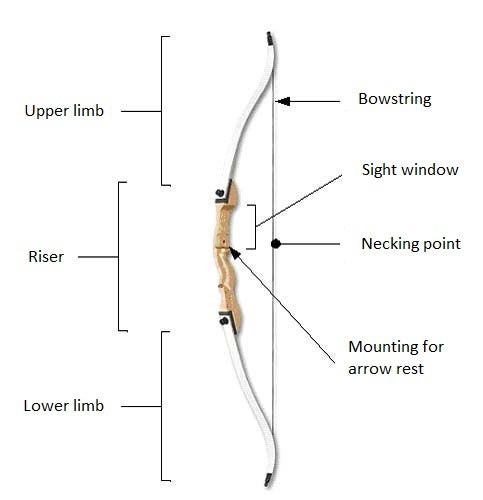
Some recurve users are attracted to the simplicity. There are only two parts, the bow and the string, and they’re both unlikely to malfunction when taken care of.
Many, like myself, switch for something that gives a greater sense of satisfaction, challenge, and accomplishment than hunting with modern technology.
It’s up to you, but I will tell you that becoming proficient with a stick bow brings a great sense of satisfaction and accomplishment. You’ll truly earn every shot you make with a recurve.
Video: Recurve Bow vs Compound Bow
Not to mention who can argue that a traditional recurve bow is just nicer to look at than some of the newer compound bows that really no longer even look like a bow but something out of a science fiction movie!
Hunting Recurve Bows Vs Target Recurve Bows
Yep, there’s a difference. A hunting recurve bow is going to play by a whole different set of rules than target bows.
- Hunting bows, draw weight is usually 60 to 70 pounds, target recurve bows usually between 40 and 50 pounds
- Color for target shooting color doesn’t matter, hunting bows a non shiny, camo pattern is best.
- In general target bows are longer for more stability, while recurve bow hunting you want a shorter bow for easier maneuverability.
In general bow makers will already have calculated a bow’s length, draw weight, and draw length for you. Unless you really want to dial in your bow, it’s usually just fine to go with a standard bow off the shelf – unless you have a very unusual draw length or draw weight requirement.
If you want to double check that you’ve got the right size bow, make sure to read this extremely helpful article on choosing bow length.
Target recurves, or competition bows, generally have different requirements and you should go to a professional to get the correct bow for you!
Draw Length
This is the last statistic you’ll want to pay major attention to when picking out your new bow. Draw length is relatively easy to measure if you’ve got the equipment for it.
Any archery shop is going to have a little toy bow with a yardstick on it which will measure your draw length. Have an archery tech help you measure to determine your draw length.
Video: How to Measure Draw Length for a Recurve Bow
| Calculated Draw Length = Bow Size: | |
| 14″ to 16″ = | 48″ Bow |
| 17″ to 20″ = | 54″ Bow |
| 20″ to 22″ = | 58″ Bow |
| 22″ to 24″ = | 62″ bow |
| 24″ to 26″ = | 64″ to 66″ bow |
| 26″ to 28″ = | 66″ to 68″ bow |
| 28″ to 30″ = | 68″ to 70″ bow |
| 31″ and longer = | 70″ to 72″ bow |
Once you know this draw length you can work backwards to determine bow length (the proper way to do it) using the link above.
Best Brands of Recurve Bows
There are many manufactures of recurve bows but only a few have been in business for decades like these brands:
Martin Archery – Based in Walla Walla Washington, they have been in business since 1951 and believe it or not they still make their bow in the USA unlike many bows nowadays.
Bear Archery – Founded in 1933 by Fred Bear. It has been since bought by Eascalade Sports but they have maintain a tradition of quality and now manufacture their bows in Gainesville FL.
Samick Archery – Samick has not been around for quite as long as Martin and Bear but that doesn’t mean their recurve bows are not as good. Samick is focused solely on recurve bows.
How to Aim a Recurve Bow
How to Shoot a Recurve Bow
FAQ About The Best Recurve Bows
Q: Is a recurve bow better than a longbow?
A: A recurve is better in that the curved shape at the end of the limbs means that it can have a larger draw weight and shoot arrows faster than a comparatively sized long bow.
Q: How do I choose a recurve bow?
A: There a few things you need to consider.
- Which eye is dominant, is it your right or left? Choose a right or left handed bow to match your eye dominance.
- Choose an appropriate draw weight, you should go to to a archery store if possible to determine this.
- Determine your draw length, you should also check with a professional in an archery store to determine the correct length.
Q: How does a recurve bow work?
A: A recurve bow like any bow, stores energy in the wood or fiberglass limbs when you pull back on the draw string. The energy is then transferred to the arrow when you release the draw string.
Q: What kind of wood is used to make a recurve bow?
A: A recurve bow can be made most any hardwood like: hickory, mulberry, walnut, ash, cherry and hickory. While there is a long list of potential woods that can be used, Maple is far and away the most common wood used in recurve bows.
Q: Is wood the only material used in recurve bows?
A: For traditional recurve bows a laminate of wood is used less powerful and/or more inexpensive bows a fiberglass laminate is used.
Q: What is a take down recurve bow?
A: A takedown recurve bow consists of a riser with the two limbs that can be disconnected from the riser. If offers two advantages over a standard recurve bow in that is can be stored in a much shorter carry case and you can change the bow configuration by changing out the limbs.
Outside Pursuits Overview
Finding the right bow for you can be a challenge. It’s not a bad idea if you have one available is going to a reputable shop that you trust and get sized for your bow by a professional.
Shooting a bow that’s the wrong size or weight for you can be difficult and decrease your enjoyment, accuracy, and effectiveness with your new bow.
Remember that shooting a recurve is a rewarding but challenging skill that will take many hundreds of hours of practice to become proficient.
Once you enter the world of stick bows, you won’t want to shoot anything else. If you’re interested in competition shooting see the NFAA website.
How We Researched
To come up with the top recurve bows we researched a variety of sources for reviews such as Cabelas, Dicks Sporting Goods and Bass Pro Shops along with our own personal experience.
We also consulted online magazines for product research and reviews to get as much unbiased information as we could. To help weed out fake reviews we used Fakespot.com to make sure we only looked at genuine reviews.
With so much quality gear available, we had to narrow it down based on what we felt were the best options for the price. The author Casey Fiedler, has been a bow hunter for decades and is hunting guide in his native state of Michigan.
To help narrow down the selection they used their personal experience along with recommendations from fellow hunters and guides.
After extensive research, we came up with our list to help you choose the right one for you.
Sources
I hope this guide was helpful for finding a good recurve bow to fit your needs. If you want to comment or recommend a bow I didn’t include, please use my contact form to get in touch.

